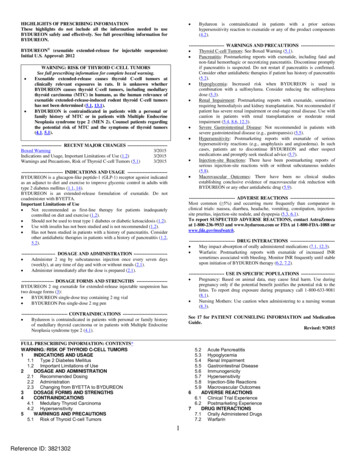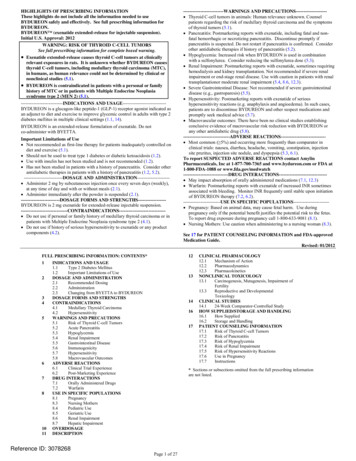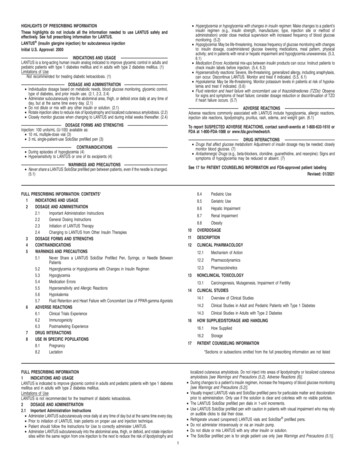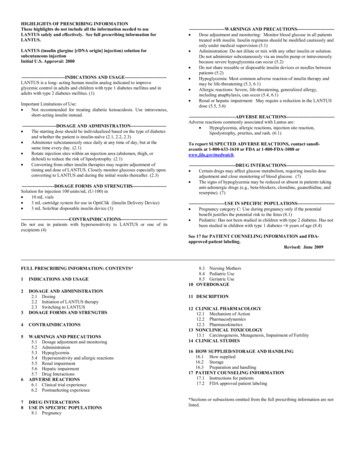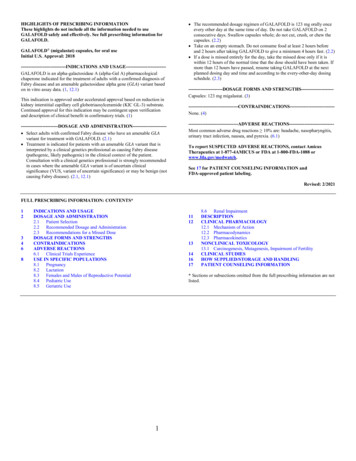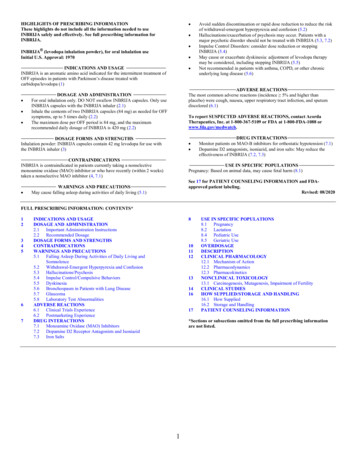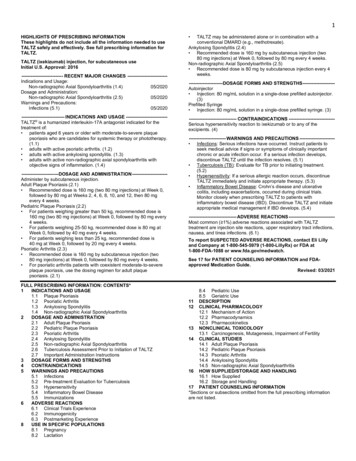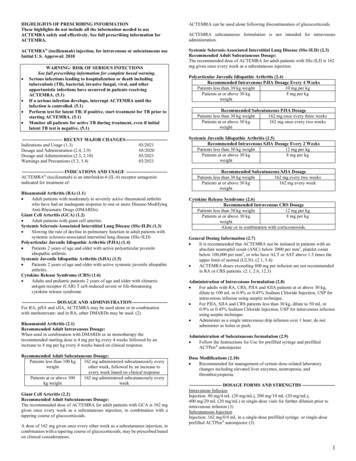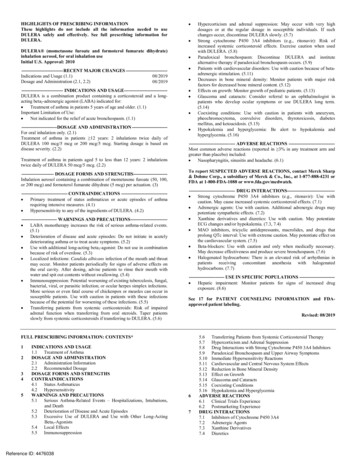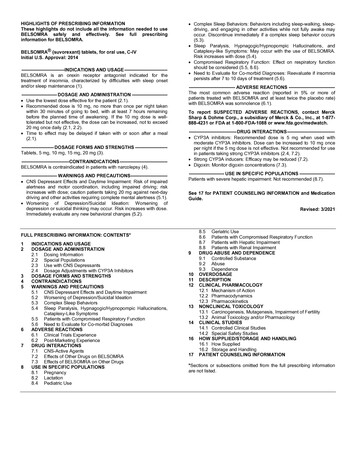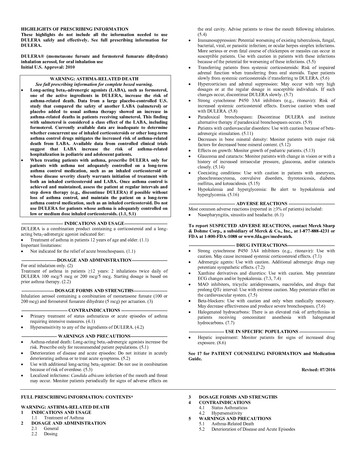
Transcription
HIGHLIGHTS OF PRESCRIBING INFORMATIONThese highlights do not include all the information needed to useDULERA safely and effectively. See full prescribing information forDULERA.DULERA (mometasone furoate and formoterol fumarate dihydrate)inhalation aerosol, for oral inhalation useInitial U.S. Approval: 2010 WARNING: ASTHMA-RELATED DEATHSee full prescribing information for complete boxed warning.Long-acting beta2-adrenergic agonists (LABA), such as formoterol,one of the active ingredients in DULERA, increase the risk ofasthma-related death. Data from a large placebo-controlled U.S.study that compared the safety of another LABA (salmeterol) orplacebo added to usual asthma therapy showed an increase inasthma-related deaths in patients receiving salmeterol. This findingwith salmeterol is considered a class effect of the LABA, includingformoterol. Currently available data are inadequate to determinewhether concurrent use of inhaled corticosteroids or other long-termasthma control drugs mitigates the increased risk of asthma-relateddeath from LABA. Available data from controlled clinical trialssuggest that LABA increase the risk of asthma-relatedhospitalization in pediatric and adolescent patients.When treating patients with asthma, prescribe DULERA only forpatients with asthma not adequately controlled on a long-termasthma control medication, such as an inhaled corticosteroid orwhose disease severity clearly warrants initiation of treatment withboth an inhaled corticosteroid and LABA. Once asthma control isachieved and maintained, assess the patient at regular intervals andstep down therapy (e.g., discontinue DULERA) if possible withoutloss of asthma control, and maintain the patient on a long-termasthma control medication, such as an inhaled corticosteroid. Do notuse DULERA for patients whose asthma is adequately controlled onlow or medium dose inhaled corticosteroids. (1.1, 5.1)--------------------------- INDICATIONS AND USAGE---------------------------DULERA is a combination product containing a corticosteroid and a longacting beta2-adrenergic agonist indicated for: Treatment of asthma in patients 12 years of age and older. (1.1)Important limitations: Not indicated for the relief of acute bronchospasm. (1.1)-----------------------DOSAGE AND ADMINISTRATION ----------------------For oral inhalation only. (2)Treatment of asthma in patients 12 years: 2 inhalations twice daily ofDULERA 100 mcg/5 mcg or 200 mcg/5 mcg. Starting dosage is based onprior asthma therapy. (2.2)--------------------- DOSAGE FORMS AND STRENGTHS---------------------Inhalation aerosol containing a combination of mometasone furoate (100 or200 mcg) and formoterol fumarate dihydrate (5 mcg) per actuation. (3)------------------------------ CONTRAINDICATIONS ----------------------------- Primary treatment of status asthmaticus or acute episodes of asthmarequiring intensive measures. (4.1) Hypersensitivity to any of the ingredients of DULERA. (4.2)----------------------- WARNINGS AND PRECAUTIONS----------------------- Asthma-related death: Long-acting beta2-adrenergic agonists increase therisk. Prescribe only for recommended patient populations. (5.1) Deterioration of disease and acute episodes: Do not initiate in acutelydeteriorating asthma or to treat acute symptoms. (5.2) Use with additional long-acting beta2-agonist: Do not use in combinationbecause of risk of overdose. (5.3) Localized infections: Candida albicans infection of the mouth and throatmay occur. Monitor patients periodically for signs of adverse effects onFULL PRESCRIBING INFORMATION: CONTENTS*WARNING: ASTHMA-RELATED DEATH1INDICATIONS AND USAGE1.1 Treatment of Asthma2DOSAGE AND ADMINISTRATION2.1 General2.2 Dosing the oral cavity. Advise patients to rinse the mouth following inhalation.(5.4)Immunosuppression: Potential worsening of existing tuberculosis, fungal,bacterial, viral, or parasitic infection; or ocular herpes simplex infections.More serious or even fatal course of chickenpox or measles can occur insusceptible patients. Use with caution in patients with these infectionsbecause of the potential for worsening of these infections. (5.5)Transferring patients from systemic corticosteroids: Risk of impairedadrenal function when transferring from oral steroids. Taper patientsslowly from systemic corticosteroids if transferring to DULERA. (5.6)Hypercorticism and adrenal suppression: May occur with very highdosages or at the regular dosage in susceptible individuals. If suchchanges occur, discontinue DULERA slowly. (5.7)Strong cytochrome P450 3A4 inhibitors (e.g., ritonavir): Risk ofincreased systemic corticosteroid effects. Exercise caution when usedwith DULERA. (5.8)Paradoxical bronchospasm: Discontinue DULERA and institutealternative therapy if paradoxical bronchospasm occurs. (5.9)Patients with cardiovascular disorders: Use with caution because of betaadrenergic stimulation. (5.11)Decreases in bone mineral density: Monitor patients with major riskfactors for decreased bone mineral content. (5.12)Effects on growth: Monitor growth of pediatric patients. (5.13)Glaucoma and cataracts: Monitor patients with change in vision or with ahistory of increased intraocular pressure, glaucoma, and/or cataractsclosely. (5.14)Coexisting conditions: Use with caution in patients with aneurysm,pheochromocytoma, convulsive disorders, thyrotoxicosis, diabetesmellitus, and ketoacidosis. (5.15)Hypokalemia and hyperglycemia: Be alert to hypokalemia andhyperglycemia. (5.16)------------------------------ ADVERSE REACTIONS -----------------------------Most common adverse reactions (reported in 3% of patients) included: Nasopharyngitis, sinusitis and headache. (6.1)To report SUSPECTED ADVERSE REACTIONS, contact Merck Sharp& Dohme Corp., a subsidiary of Merck & Co., Inc., at 1-877-888-4231 orFDA at 1-800-FDA-1088 or - DRUG INTERACTIONS------------------------------ Strong cytochrome P450 3A4 inhibitors (e.g., ritonavir): Use withcaution. May cause increased systemic corticosteroid effects. (7.1) Adrenergic agents: Use with caution. Additional adrenergic drugs maypotentiate sympathetic effects. (7.2) Xanthine derivatives and diuretics: Use with caution. May potentiateECG changes and/or hypokalemia. (7.3, 7.4) MAO inhibitors, tricyclic antidepressants, macrolides, and drugs thatprolong QTc interval: Use with extreme caution. May potentiate effect onthe cardiovascular system. (7.5) Beta-blockers: Use with caution and only when medically necessary.May decrease effectiveness and produce severe bronchospasm. (7.6) Halogenated hydrocarbons: There is an elevated risk of arrhythmias inpatients receiving concomitant anesthesia with halogenatedhydrocarbons. (7.7)----------------------- USE IN SPECIFIC POPULATIONS ---------------------- Hepatic impairment: Monitor patients for signs of increased drugexposure. (8.6)See 17 for PATIENT COUNSELING INFORMATION and MedicationGuide.Revised: 07/2016345DOSAGE FORMS AND STRENGTHSCONTRAINDICATIONS4.1 Status Asthmaticus4.2 HypersensitivityWARNINGS AND PRECAUTIONS5.1 Asthma-Related Death5.2 Deterioration of Disease and Acute Episodes
5.367Excessive Use of DULERA and Use with Other Long-ActingBeta2-Agonists5.4 Local Effects5.5 Immunosuppression5.6 Transferring Patients from Systemic Corticosteroid Therapy5.7 Hypercorticism and Adrenal Suppression5.8 Drug Interactions with Strong Cytochrome P450 3A4 Inhibitors5.9 Paradoxical Bronchospasm and Upper Airway Symptoms5.10 Immediate Hypersensitivity Reactions5.11 Cardiovascular and Central Nervous System Effects5.12 Reduction in Bone Mineral Density5.13 Effect on Growth5.14 Glaucoma and Cataracts5.15 Coexisting Conditions5.16 Hypokalemia and HyperglycemiaADVERSE REACTIONS6.1 Clinical Trials Experience6.2 Postmarketing ExperienceDRUG INTERACTIONS7.1 Inhibitors of Cytochrome P450 3A47.2 Adrenergic Agents7.3 Xanthine Derivatives7.4 Diuretics7.5 Monoamine Oxidase Inhibitors, Tricyclic Antidepressants, andDrugs Known to Prolong the QTc Interval7.6 Beta-Adrenergic Receptor Antagonists7.7 Halogenated Hydrocarbons810111213141617USE IN SPECIFIC POPULATIONS8.1 Pregnancy8.2 Lactation8.4 Pediatric Use8.5 Geriatric Use8.6 Hepatic ImpairmentOVERDOSAGE10.1 Signs and Symptoms10.2 TreatmentDESCRIPTIONCLINICAL PHARMACOLOGY12.1 Mechanism of Action12.2 Pharmacodynamics12.3 PharmacokineticsNONCLINICAL TOXICOLOGY13.1 Carcinogenesis, Mutagenesis, Impairment of Fertility13.2 Animal Toxicology and/or PharmacologyCLINICAL STUDIES14.1 AsthmaHOW SUPPLIED/STORAGE AND HANDLING16.1 How Supplied16.2 Storage and HandlingPATIENT COUNSELING INFORMATION*Sections or subsections omitted from the full prescribing information are notlisted.FULL PRESCRIBING INFORMATIONWARNING: ASTHMA-RELATED DEATHLong-acting beta2-adrenergic agonists (LABA), such as formoterol, one of the active ingredients in DULERA, increase the riskof asthma-related death. Data from a large placebo-controlled U.S. study that compared the safety of another long-actingbeta2-adrenergic agonist (salmeterol) or placebo added to usual asthma therapy showed an increase in asthma-related deathsin patients receiving salmeterol. This finding with salmeterol is considered a class effect of the LABA, including formoterol.Currently available data are inadequate to determine whether concurrent use of inhaled corticosteroids or other long-termasthma control drugs mitigates the increased risk of asthma-related death from LABA. Available data from controlled clinicaltrials suggest that LABA increase the risk of asthma-related hospitalization in pediatric and adolescent patients. Therefore,when treating patients with asthma, DULERA should only be used for patients not adequately controlled on a long-termasthma control medication, such as an inhaled corticosteroid or whose disease severity clearly warrants initiation of treatmentwith both an inhaled corticosteroid and LABA. Once asthma control is achieved and maintained, assess the patient at regularintervals and step down therapy (e.g., discontinue DULERA) if possible without loss of asthma control, and maintain thepatient on a long-term asthma control medication, such as an inhaled corticosteroid. Do not use DULERA for patients whoseasthma is adequately controlled on low or medium dose inhaled corticosteroids. [See Warnings and Precautions (5.1).]1INDICATIONS AND USAGE1.1 Treatment of AsthmaDULERA is indicated for the treatment of asthma in patients 12 years of age and older.Long-acting beta2-adrenergic agonists, such as formoterol, one of the active ingredients in DULERA, increase the risk of asthmarelated death. Available data from controlled clinical trials suggest that LABA increase the risk of asthma-related hospitalization inpediatric and adolescent patients [see Warnings and Precautions (5.1)]. Therefore, when treating patients with asthma, DULERAshould only be used for patients not adequately controlled on a long-term asthma control medication, such as an inhaled corticosteroidor whose disease severity clearly warrants initiation of treatment with both an inhaled corticosteroid and LABA. Once asthma controlis achieved and maintained, assess the patient at regular intervals and step down therapy (e.g., discontinue DULERA) if possiblewithout loss of asthma control, and maintain the patient on a long-term asthma control medication, such as an inhaled corticosteroid.Do not use DULERA for patients whose asthma is adequately controlled on low or medium dose inhaled corticosteroids.Important Limitation of Use DULERA is NOT indicated for the relief of acute bronchospasm.2
2DOSAGE AND ADMINISTRATION2.1 GeneralDULERA should be administered only by the orally inhaled route (see Patient Instructions for Use in the Medication Guide). Aftereach dose, the patient should be advised to rinse his/her mouth with water without swallowing.The cap from the mouthpiece of the actuator should be removed before using DULERA.DULERA should be primed before using for the first time by releasing 4 test sprays into the air, away from the face, shaking wellbefore each spray. In cases where the inhaler has not been used for more than 5 days, prime the inhaler again by releasing 4 test spraysinto the air, away from the face, shaking well before each spray.The DULERA canister should only be used with the DULERA actuator. The DULERA actuator should not be used with any otherinhalation drug product. Actuators from other products should not be used with the DULERA canister.2.2 DosingDULERA should be administered as two inhalations twice daily every day (morning and evening) by the orally inhaled route.Shake well prior to each inhalation.The recommended starting dosages for DULERA treatment are based on prior asthma therapy.Table 1: Recommended Dosages for DULERARecommended DoseMaximum Recommended DailyDoseInhaled medium doseDULERA 100 mcg/5 mcg, 2400 mcg/20 mcgcorticosteroidsinhalations twice dailyInhaled high dose corticosteroidsDULERA 200 mcg/5 mcg, 2800 mcg/20 mcginhalations twice dailyPrevious TherapyThe maximum daily recommended dose is two inhalations of DULERA 200 mcg/5 mcg twice daily. Do not use more than twoinhalations twice daily of the prescribed strength of DULERA as some patients are more likely to experience adverse effects withhigher doses of formoterol. If symptoms arise between doses, an inhaled short-acting beta2-agonist should be taken for immediaterelief.If a previously effective dosage regimen of DULERA fails to provide adequate control of asthma, the therapeutic regimen should bere-evaluated and additional therapeutic options, e.g., replacing the current strength of DULERA with a higher strength, addingadditional inhaled corticosteroid, or initiating oral corticosteroids, should be considered.The maximum benefit may not be achieved for 1 week or longer after beginning treatment. Individual patients may experience avariable time to onset and degree of symptom relief. For patients 12 years of age who do not respond adequately after 2 weeks oftherapy, higher strength may provide additional asthma control.3DOSAGE FORMS AND STRENGTHSDULERA is a pressurized metered dose inhaler that is available in 2 strengths.DULERA 100 mcg/5 mcg delivers 100 mcg of mometasone furoate and 5 mcg of formoterol fumarate dihydrate per actuation.DULERA 200 mcg/5 mcg delivers 200 mcg of mometasone furoate and 5 mcg of formoterol fumarate dihydrate per actuation.4CONTRAINDICATIONS4.1 Status AsthmaticusDULERA is contraindicated in the primary treatment of status asthmaticus or other acute episodes of asthma where intensivemeasures are required.4.2 HypersensitivityDULERA is contraindicated in patients with known hypersensitivity to mometasone furoate, formoterol fumarate, or any of theingredients in DULERA [see Warnings and Precautions (5.10)].3
5WARNINGS AND PRECAUTIONS5.1 Asthma-Related DeathLong-acting beta2-adrenergic agonists, such as formoterol, one of the active ingredients in DULERA, increase the risk ofasthma-related death. Currently available data are inadequate to determine whether concurrent use of inhaled corticosteroidsor other long-term asthma control drugs mitigates the increased risk of asthma-related death from LABA. Available datafrom controlled clinical trials suggest that LABA increase the risk of asthma-related hospitalization in pediatric andadolescent patients. Therefore, when treating patients with asthma, physicians should only prescribe DULERA for patientswith asthma not adequately controlled on a long-term asthma control medication, such as an inhaled corticosteroid or whosedisease severity clearly warrants initiation of treatment with both an inhaled corticosteroid and LABA. Once asthma control isachieved and maintained, assess the patient at regular intervals and step down therapy (e.g., discontinue DULERA) if possiblewithout loss of asthma control, and maintain the patient on a long-term asthma control medication, such as an inhaledcorticosteroid. Do not use DULERA for patients whose asthma is adequately controlled on low or medium dose inhaledcorticosteroids.A 28-week, placebo-controlled US study comparing the safety of salmeterol with placebo, each added to usual asthma therapy,showed an increase in asthma-related deaths in patients receiving salmeterol (13/13,176 in patients treated with salmeterol vs.3/13,179 in patients treated with placebo; RR 4.37, 95% CI 1.25, 15.34). This finding with salmeterol is considered a class effect ofthe LABAs, including formoterol, one of the active ingredients in DULERA. No study adequate to determine whether the rate ofasthma-related death is increased with DULERA has been conducted.Clinical studies with formoterol suggested a higher incidence of serious asthma exacerbations in patients who received formoterolfumarate than in those who received placebo. The sizes of these studies were not adequate to precisely quantify the differences inserious asthma exacerbation rates between treatment groups.5.2 Deterioration of Disease and Acute EpisodesDULERA should not be initiated in patients during rapidly deteriorating or potentially life-threatening episodes of asthma. DULERAhas not been studied in patients with acutely deteriorating asthma. The initiation of DULERA in this setting is not appropriate.Increasing use of inhaled, short-acting beta2-agonists is a marker of deteriorating asthma. In this situation, the patient requiresimmediate re-evaluation with reassessment of the treatment regimen, giving special consideration to the possible need for replacingthe current strength of DULERA with a higher strength, adding additional inhaled corticosteroid, or initiating systemic corticosteroids.Patients should not use more than 2 inhalations twice daily (morning and evening) of DULERA.DULERA is not indicated for the relief of acute symptoms, i.e., as rescue therapy for the treatment of acute episodes of bronchospasm.An inhaled, short-acting beta2-agonist, not DULERA, should be used to relieve acute symptoms such as shortness of breath. Whenprescribing DULERA, the physician must also provide the patient with an inhaled, short-acting beta2-agonist (e.g., albuterol) fortreatment of acute symptoms, despite regular twice-daily (morning and evening) use of DULERA.When beginning treatment with DULERA, patients who have been taking oral or inhaled, short-acting beta2-agonists on a regularbasis (e.g., 4 times a day) should be instructed to discontinue the regular use of these drugs.5.3 Excessive Use of DULERA and Use with Other Long-Acting Beta2-AgonistsAs with other inhaled drugs containing beta2-adrenergic agents, DULERA should not be used more often than recommended, at higherdoses than recommended, or in conjunction with other medications containing long-acting beta2-agonists, as an overdose may result.Clinically significant cardiovascular effects and fatalities have been reported in association with excessive use of inhaledsympathomimetic drugs. Patients using DULERA should not use an additional long-acting beta2-agonist (e.g., salmeterol, formoterolfumarate, arformoterol tartrate) for any reason, including prevention of exercise-induced bronchospasm (EIB) or the treatment ofasthma.5.4 Local EffectsIn clinical trials, the development of localized infections of the mouth and pharynx with Candida albicans have occurred in patientstreated with DULERA. If oropharyngeal candidiasis develops, it should be treated with appropriate local or systemic (i.e., oral)antifungal therapy while remaining on treatment with DULERA therapy, but at times therapy with DULERA may need to beinterrupted. Advise patients to rinse the mouth after inhalation of DULERA.5.5 ImmunosuppressionPersons who are using drugs that suppress the immune system are more susceptible to infections than healthy individuals.Chickenpox and measles, for example, can have a more serious or even fatal course in susceptible children or adults usingcorticosteroids. In such children or adults who have not had these diseases or who are not pr
DULERA should be administered only by the orally inhaled route (see Patient Instructions for Usein the Medication Guide). After each dose, the patient should be advised to rinse his/her mouth with water without swallowing. The cap from the mouthpiece of the actuato
